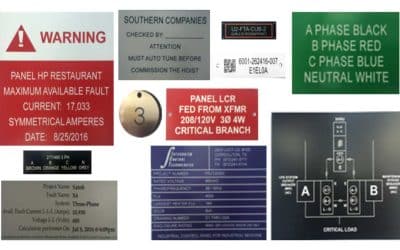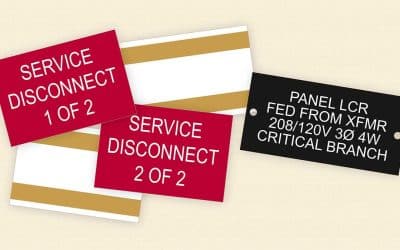In the world of industrial engraving, phenolic material has become increasingly popular for its durability, versatility, and resistance to various environmental factors. It’s commonly used for creating tags and nameplates that serve various purposes in different industries. But what is the difference between a phenolic tag and a phenolic nameplate, and how do they each serve unique functions? Here are the key differences between these two types of phenolic products and how Action Engraving can help you choose the right solution for your needs.
Phenolic Tags
Phenolic tags are smaller, more lightweight identifiers often used to label equipment, electrical panels, valves, and other essential components in various industries. They provide crucial information regarding the function or purpose of the equipment, helping workers quickly identify and troubleshoot any issues that may arise. The primary function of a phenolic tag is to convey concise information in a format that can withstand harsh environments, such as exposure to chemicals, extreme temperatures, and UV radiation.
Some common applications of phenolic tags include:
- Asset management: These tags help businesses keep track of their valuable equipment and tools, making it easier to manage inventory and prevent loss.
- Safety warnings: Phenolic tags can be used to display important safety information, such as electrical hazards or specific instructions for handling equipment.
- Identification of valves or switches: In industrial settings, it’s crucial to know the purpose of each valve or switch to prevent accidents and ensure proper operation.
Phenolic Nameplates
Phenolic nameplates are larger, more robust labeling solutions often used to provide detailed information about a piece of equipment or machinery. They typically contain more comprehensive data, such as technical specifications, manufacturer information, safety guidelines, and other relevant details. Nameplates can also be used for branding purposes, as they often include company logos or other identifying marks.
Phenolic nameplates are commonly used for:
- Product identification: Nameplates can provide essential information about a specific product, such as its model number, serial number, or manufacturing date.
- Branding: Companies can use nameplates to display their logos or other branding elements, reinforcing their brand identity and adding a professional touch to their equipment.
- Safety and regulatory compliance: Nameplates can be used to convey important safety information and demonstrate compliance with industry standards or regulations, such as UL, CE, or ISO certifications.
Key Differences
- Size and complexity: Phenolic tags are generally smaller and simpler than nameplates, containing only the most critical information. Nameplates, on the other hand, can be larger and more detailed, providing a wealth of information about a specific product or piece of equipment.
- Applications: While both phenolic tags and nameplates can be used for identification purposes, tags are typically more suited for labeling individual components or assets, whereas nameplates are designed to provide comprehensive information about a complete product or system.
- Customization: Both phenolic tags and nameplates can be customized to suit specific needs, but nameplates generally offer more options in terms of design, layout, and information displayed.
Understanding the differences between phenolic tags and phenolic nameplates is essential for selecting the right solution for your specific needs. At Action Engraving, we specialize in creating both types of phenolic products, ensuring that you receive the highest quality engraving and materials for your project. Whether you need simple, durable tags for asset management or comprehensive, informative nameplates for product identification and branding, our team of experts is here to help you make the best decision for your business. Contact us today to learn more about our phenolic engraving services and how we can create the perfect custom solution for your needs.




